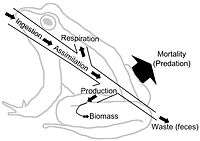Energy flow (ecology)


Right: An expanded three link energy food chain (1. plants, 2. herbivores, 3. carnivores) illustrating the relationship between food flow diagrams and energy transformity. The transformity of energy becomes degraded, dispersed, and diminished from higher quality to lesser quantity as the energy within a food chain flows from one trophic species into another. Abbreviations: I=input, A=assimilation, R=respiration, NU=not utilized, P=production, B=biomass.[1]
In ecology, energy flow, also called the calorific flow, refers to the flow of energy through a food chain, and is the focus of study in ecological energetics. In an ecosystem, ecologists seek to quantify the relative importance of different component species and feeding relationships.
A general energy flow scenario follows:
- Solar energy is fixed by the photoautotrophs, called primary producers, like green plants. Primary consumers absorb most of the stored energy in the plant through digestion, and transform it into the form of energy they need, such as adenosine triphosphate (ATP), through respiration. A part of the energy received by primary consumers, herbivores, is converted to body heat (an effect of respiration), which is radiated away and lost from the system. The loss of energy through body heat is far greater in warm-blooded animals, which must eat much more frequently than those that are cold-blooded. Energy loss also occurs in the expulsion of undigested food (egesta) by excretion or regurgitation.
- Secondary consumers, carnivores, then consume the primary consumers, although omnivores also consume primary producers. Energy that had been used by the primary consumers for growth and storage is thus absorbed into the secondary consumers through the process of digestion. As with primary consumers, secondary consumers convert this energy into a more suitable form (ATP) during respiration. Again, some energy is lost from the system, since energy which the primary consumers had used for respiration and regulation of body temperature cannot be utilized by the secondary consumers.
- Tertiary consumers, which may or may not be apex predators, then consume the secondary consumers, with some energy passed on and some lost, as with the lower levels of the food chain.
- A final link in the food chain are decomposers which break down the organic matter of the tertiary consumers (or whichever consumer is at the top of the chain) and release nutrients into the soil. They also break down plants, herbivores and carnivores that were not eaten by organisms higher on the food chain, as well as the undigested food that is excreted by herbivores and carnivores. Saprotrophic bacteria and fungi are decomposers, and play a pivotal role in the nitrogen and carbon cycles.
The energy is passed on from trophic level to trophic level and each time about 90% of the energy is lost, with some being lost as heat into the environment (an effect of respiration) and some being lost as incompletely digested food (egesta). Therefore, primary consumers get about 10% of the energy produced by autotrophs, while secondary consumers get 1% and tertiary consumers get 0.1%. This means the top consumer of a food chain receives the least energy, as a lot of the food chain's energy has been lost between trophic levels. This loss of energy at each level limits typical food chains to only four to six links.
History of ecological energetics
Ecological energetics appears to have grown out of the Age of Enlightenment and the concerns of the Physiocrats. It began in the works of Sergei Podolinsky in the late 1800s, and subsequently was developed by the Soviet ecologist Vladmir Stanchinsky, the Austro-American Alfred J. Lotka, and American limnologists, Raymond Lindeman and G. Evelyn Hutchinson. It underwent substantial development by Howard T. Odum and was applied by systems ecologists, and radiation ecologists.
See also
References
- ↑ Odum, H. T. (1988). "Self-organization, transformity, and information". Science. 242 (4882): 1132–1139. Bibcode:1988Sci...242.1132O. doi:10.1126/science.242.4882.1132. JSTOR 1702630. PMID 17799729.
Further reading
- S. Podolinsky (2004). "Socialism and the Unity of Physical Forces". Organization & Environment. 17 (1): 61–75. doi:10.1177/1086026603262092.
- D.R. Weiner (2000). Models of Nature: Ecology, Conservation and Cultural Revolution in Soviet Russia. U.S.: University of Pittsburgh Press.